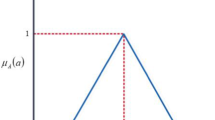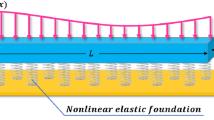Abstract
Vibration-based damage detection methods have become widely used because of their advantages over traditional methods. This paper presents a new approach to identify the crack depth in steel beam structures based on vibration analysis using the Finite Element Method (FEM) and Artificial Neural Network (ANN) combined with Butterfly Optimization Algorithm (BOA). ANN is quite successful in such identification issues, but it has some limitations, such as reduction of error after system training is complete, which means the output does not provide optimal results. This paper improves ANN training after introducing BOA as a hybrid model (BOA-ANN). Natural frequencies are used as input parameters and crack depth as output. The data are collected from improved FEM using simulation tools (ABAQUS) based on different crack depths and locations as the first stage. Next, data are collected from experimental analysis of cracked beams based on different crack depths and locations to test the reliability of the presented technique. The proposed approach, compared to other methods, can predict crack depth with improved accuracy.
Similar content being viewed by others
References
Magagnini E, Khatir S. Effect of damage by notches in the vibration response of homogeneous and heterogeneous beam models. Lecture Notes in Civil Engineering, 2021, 148: 187–197
Capozucca R, Magagnini E. Analysis of cracked RC beams under vibration. Journal of Physics: Conference Series, 2017, 842(1): 012076
Kumar P, Siddiqui A, Ghadi A, Tony D, Rhenius S, Rane S. Damage detection in beams using vibration analysis and artificial neural network. In: 2021 4th Biennial International Conference on Nascent Technologies in Engineering (ICNTE). Chengdu: IEEE, 2021, 1–5
Seguini M, Khatir S, Boutchicha D, Nedjar D, Wahab M A. Crack prediction in pipeline using ANN-PSO based on numerical and experimental modal analysis. Smart Structures and Systems, 2021, 27: 507–523
Khatir S, Boutchicha D, Le Thanh C, Tran-Ngoc H, Nguyen T N, Abdel-Wahab M. Improved ANN technique combined with Jaya algorithm for crack identification in plates using XIGA and experimental analysis. Theoretical and Applied Fracture Mechanics, 2020, 107: 102554
Nourani B, Salmasi F, Ghorbani M A. Modeling and estimating the uplift force of gravity dams using finite element and artificial neural network whale optimization algorithm methods. Amirkabir Journal of Civil Engineering, 2020, 52(7): 393–396
Mehrjoo M, Khaji N, Moharrami H, Bahreininejad A. Damage detection of truss bridge joints using artificial neural networks. Expert Systems with Applications, 2008, 35(3): 1122–1131
Yeung W T, Smith J W. Damage detection in bridges using neural networks for pattern recognition of vibration signatures. Engineering Structures, 2005, 27(5): 685–698
Khatir S, Wahab M A, Tiachacht S, Le Thanh C, Capozucca R, Magagnini E, Benaissa B. Damage identification in steel plate using FRF and inverse analysis. Fracture and Structural Integrity, 2021, 15(58): 416–433
Maity D, Saha A. Damage assessment in structure from changes in static parameter using neural networks. Sadhana, 2004, 29(3): 315–327
Cunha E, Caetano E. Experimental modal analysis of civil engineering structures. Sound and Vibration, 2006, 40: 12–20
Padil K H, Bakhary N, Muyideen A, Li J, Hao H. Non-probabilistic method to consider uncertainties in frequency response function for vibration-based damage detection using artificial neural network. Journal of Sound and Vibration, 2020, 467: 115069
Khiem N T, Lien T V. Multi-crack detection for beam by the natural frequencies. Journal of Sound and Vibration, 2004, 273(1–2): 175–184
Lee J J, Lee J W, Yi J H, Yun C B, Jung H Y. Neural networks-based damage detection for bridges considering errors in baseline finite element models. Journal of Sound and Vibration, 2005, 280(3–5): 555–578
Anitescu C, Atroshchenko E, Alajlan N, Rabczuk T. Artificial neural network methods for the solution of second order boundary value problems. Computers, Materials & Continua, 2019, 59(1): 345–359
Samaniego E, Anitescu C, Goswami S, Nguyen-Thanh V M, Guo H, Hamdia K, Zhuang X, Rabczuk T. An energy approach to the solution of partial differential equations in computational mechanics via machine learning: Concepts, implementation and applications. Computer Methods in Applied Mechanics and Engineering, 2020, 362: 112790
Zhuang X, Guo H, Alajlan N, Zhu H, Rabczuk T. Deep autoencoder based energy method for the bending, vibration, and buckling analysis of Kirchhoff plates with transfer learning. European Journal of Mechanics. A, Solids, 2021, 87: 104225
Guo H, Zhuang X, Rabczuk T. A deep collocation method for the bending analysis of Kirchhoff plate. 2021, arXiv:2102.02617
Nguyen-Thanh V M, Anitescu C, Alajlan N, Rabczuk T, Zhuang X. Parametric deep energy approach for elasticity accounting for strain gradient effects. Computer Methods in Applied Mechanics and Engineering, 2021, 386: 114096
Nanthakumar S S, Lahmer T, Zhuang X, Zi G, Rabczuk T. Detection of material interfaces using a regularized level set method in piezoelectric structures. Inverse Problems in Science and Engineering, 2016, 24(1): 153–176
Arora S, Singh S. Butterfly optimization algorithm: A novel approach for global optimization. Soft Computing, 2019, 23(3): 715–734
Arora S, Singh S. An improved butterfly optimization algorithm with chaos. Journal of Intelligent & Fuzzy Systems, 2017, 32(1): 1079–1088
Arora S, Singh S. An effective hybrid butterfly optimization algorithm with artificial bee colony for numerical optimization. International Journal of Interactive Multimedia and Artificial Intelligence, 2017, 4(4): 14–21
Faravelli L, Materazzi F, Rarina M. Genetic algorithms for structural identification. Proceedings of ICOSSAR, 2005, 5: 3115–3121
Casciati S. Stiffness identification and damage localization via differential evolution algorithms. Structural Control and Health Monitoring, 2008, 15(3): 436–449
Khatir A, Tehami M, Khatir S, Abdel Wahab M. Multiple damage detection and localization in beam-like and complex structures using co-ordinate modal assurance criterion combined with firefly and genetic algorithms. Journal of Vibroengineering, 2016, 18(8): 5063–5073
Samir K, Idir B, Serra R, Brahim B, Aicha A. Genetic algorithm based objective functions comparative study for damage detection and localization in beam structures. Journal of Physics: Conference Series, 2015, 628(1): 012035
Horibe T, Watanabe K. Crack identification of plates using genetic algorithm. JSME International Journal Series A Solid Mechanics and Material Engineering, 2006, 49(3): 403–410
Lai X, Zhang M. An efficient ensemble of GA and PSO for real function optimization. In: Proceedings of the 2009 2nd IEEE International Conference on Computer Science and Information Technology. Beijing: IEEE, 2009, 651–655
Khatir A, Tehami M, Khatir S, Wahab M A. Damage detection and localization on thin plates using vibration analysis. Research in Veterinary Science, 2016, 106: 107–111
Zenzen R, Belaidi I, Khatir S, Wahab M A. A damage identification technique for beam-like and truss structures based on FRF and Bat Algorithm. Mecanical Reports, 2018, 346(12): 1253–1266
Ghannadi P, Kourehli S S. Structural damage detection based on MAC flexibility and frequency using moth-flame algorithm. Structural Engineering and Mechanics, 2019, 70(6): 649–659
Moezi S A, Zakeri E, Zare A, Nedaei M. On the application of modified cuckoo optimization algorithm to the crack detection problem of cantilever Euler-Bernoulli beam. Computers & Structures, 2015, 157: 42–50
Kim J T, Stubbs N. Crack detection in beam type structures using frequency data. Journal of Sound and Vibration, 2003, 259(1): 145–160
Huang M, Cheng S, Zhang H, Gul M, Lu H. Structural damage identification under temperature variations based on PSO-CS hybrid algorithm. International Journal of Structural Stability and Dynamics, 2019, 19(11): 1950139
Baghmisheh M V, Peimani M, Sadeghi M H, Ettefagh M M, Tabrizi A F. A hybrid particle swarm-Nelder-Mead optimization method for crack detection in cantilever beams. Applied Soft Computing, 2012, 12(8): 2217–2226
Vakil-Baghmisheh M T, Peimani M, Sadeghi M H, Ettefagh M M. Crack detection in beam-like structures using genetic algorithms. Applied Soft Computing, 2008, 8(2): 1150–1160
Dehuri S, Cho S B. A hybrid genetic based functional link artificial neural network with a statistical comparison of classifiers over multiple datasets. Neural Computing & Applications, 2010, 19(2): 317–328
Awan S M, Aslam M, Khan Z A, Saeed H. An efficient model based on artificial bee colony optimization algorithm with Neural Networks for electric load forecasting. Neural Computing & Applications, 2014, 25(7–8): 1967–1978
Mirjalili S Z, Saremi S, Mirjalili S M. Designing evolutionary feedforward neural networks using social spider optimization algorithm. Neural Computing & Applications, 2015, 26(8): 1919–1928
Chen J F, Do Q H, Hsieh H N. Training artificial neural networks by a hybrid PSO-CS algorithm. Algorithms, 2015, 8(2): 292–308
Rukhaiyar S, Alam M N, Samadhiya N K. A PSO-ANN hybrid model for predicting factor of safety of slope. International Journal of Geotechnical Engineering, 2018, 12(6): 556–566
Shahrouzi M, Sabzi A H. Damage detection of truss structures by hybrid immune system and teaching-learning-based optimization. Asian Journal of Civil Engineering, 2018, 19(7): 811–825
Tran-Ngoc H, He L, Reynders E, Khatir S, Le-Xuan T, De Roeck G, Bui-Tien T, Wahab M A. An efficient approach to model updating for a multispan railway bridge using orthogonal diagonalization combined with improved particle swarm optimization. Journal of Sound and Vibration, 2020, 476: 115315
Chatterjee S, Sarkar S, Hore S, Dey N, Ashour A S, Balas V E. Particle swarm optimization trained neural network for structural failure prediction of multistoried RC buildings. Neural Computing & Applications, 2017, 28(8): 2005–2016
Ahmad F, Mat-Isa N A, Hussain Z, Boudville R, Osman M K. Genetic Algorithm-Artificial Neural Network (GA-ANN) hybrid intelligence for cancer diagnosis. In: 2010 2nd International Conference on Computational Intelligence, Communication Systems and Networks. Liverpool: IEEE, 2010, 78–83
Yaghini M, Khoshraftar M M, Fallahi M. A hybrid algorithm for artificial neural network training. Engineering Applications of Artificial Intelligence, 2013, 26(1): 293–301
Acknowledgements
This experimental research was supported by research funds provided by Università Politecnica Delle Marche. The authors would like to express their gratitude to all the technicians and students who collaborated to develop the experimental research.
Author information
Authors and Affiliations
Corresponding author
Rights and permissions
About this article
Cite this article
Khatir, A., Capozucca, R., Khatir, S. et al. Vibration-based crack prediction on a beam model using hybrid butterfly optimization algorithm with artificial neural network. Front. Struct. Civ. Eng. 16, 976–989 (2022). https://doi.org/10.1007/s11709-022-0840-2
Received:
Accepted:
Published:
Issue Date:
DOI: https://doi.org/10.1007/s11709-022-0840-2




